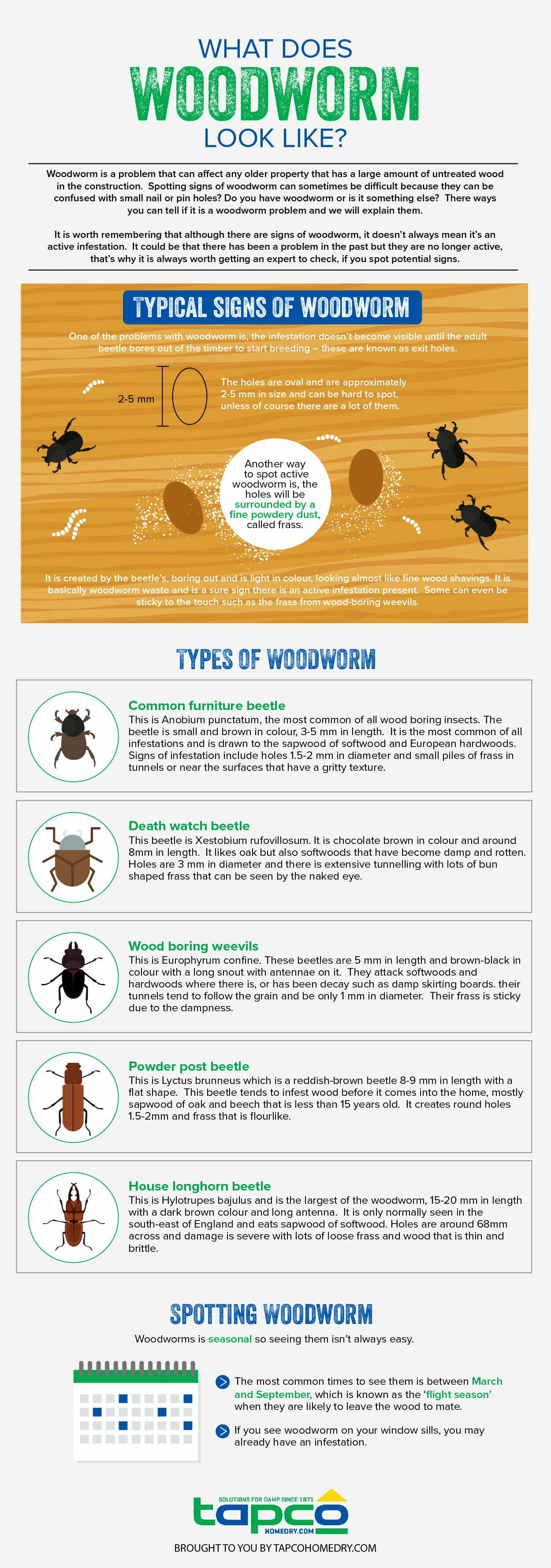Woodworm is a problem that can affect any older property that has a large amount of untreated wood in the construction. Spotting signs of woodworm holes can sometimes be difficult because they can be mistaken for small nail or pin holes? Do you have woodworm or is it something else? There are ways you can tell if it is a woodworm problem and here we explain them.
It’s worth remembering that although there are woodworm holes, it doesn’t always mean it’s still an active infestation. It could be that there has been a problem in the past which was treated, so it is no longer active. That’s why, if you spot possible signs, it is always best to instruct an expert to check it.
Typical signs of woodworm
One of the problems with woodworm is, the infestation doesn’t become visible until the adult beetle bores out of the timber to start breeding – that is why the hole it leaves is known as an exit hole. The holes are oval in shape and are only approximately 2-5 mm in size, so they can be hard to spot, unless of course there are a lot of them.
A way to telling is the woodworm is active, is the holes will be surrounded by a fine powdery dust, called frass. It is created by the beetle boring out and is light in colour, looking almost like very fine wood shavings. It is basically woodworm waste and is a sure sign there is an active infestation present. Frass from wood-boring weevils is often sticky because the insect attacks damp or wet wood.
Types of woodworm
Common furniture beetle
This is Anobium punctatum, the most common of all wood boring insects. The adult beetle is small and brown in colour, 3-5 mm in length. It is the most common of all infestations and is drawn to the sapwood of softwood and European hardwoods. Signs of infestation include holes 1.5-2 mm in diameter and small piles of frass in tunnels or near the surfaces that have a gritty texture.
Death watch beetle
This beetle is Xestobium rufovillosum. It is chocolate brown in colour and around 8mm in length. It likes oak but also softwoods that have become damp and rotten. Holes are 3 mm in diameter and there is extensive tunnelling with lots of bun shaped frass that can be seen by the naked eye.
Wood boring weevils
This is Europhyrum confine. These beetles are 5 mm in length and brown-black in colour with a long snout with antennae on it. They attack softwoods and hardwoods where there is, or has been decay such as damp skirting boards. their tunnels tend to follow the grain and be only 1 mm in diameter. Their frass is sticky due to the dampness.
Powder post beetle
This is Lyctus brunneus which is a reddish-brown beetle 8-9 mm in length with a flat shape. This beetle tends to infest wood before it comes into the home, mostly sapwood of oak and beech that is less than 15 years old. It creates round holes 1.5-2 mm and frass that is flour like in texture.
House longhorn beetle
This is Hylotrupes bajulus and is the largest of the woodworm, 15-20 mm in length with a dark brown colour and long antenna. It is normally seen in the south-east of England and rapidly eats the sapwood of softwood. Holes are around 6-8mm across and damage is severe with lots of loose frass and wood that is thin and brittle, to the point of collapse.
Spotting Woodworm
Woodworms is seasonal and spotting them isn’t always easy. The most common time is between March and September, which is known as the ‘flight season’ when they leave the wood to mate. If you see small beetles, woodworm, on your window sills or furniture, it is likely you already have an infestation eating away at your floors, furniture or roof timbers.
Want to know more about the difficulty spotting wet rot, then click here.


 Damp Proofing
Damp Proofing Basement Damp Proofing
Basement Damp Proofing Water Damage
Water Damage Condensation Control
Condensation Control Dry Rot Treatment
Dry Rot Treatment WOODWORM & WET ROT
WOODWORM & WET ROT CAVITY Wall Ties
CAVITY Wall Ties Property Maintenance
Property Maintenance Waterproofing And Tanking
Waterproofing And Tanking Structural Repairs
Structural Repairs








